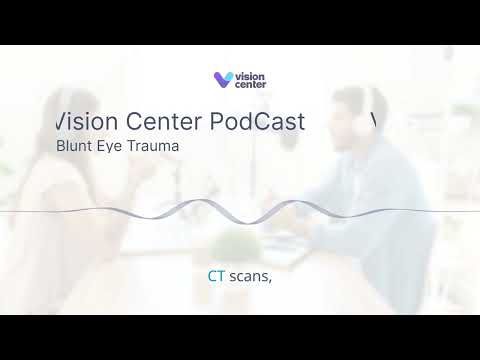Key Takeaways
- Blunt eye trauma is one of the leading causes of blindness worldwide.
- It can cause permanent damage to the eyes if not treated immediately.
- You must seek medical attention immediately if you suffer from blunt eye trauma.
What to Do After a Blunt Eye Injury
Blunt eye trauma requires immediate medical attention and should be treated within 4 hours from the onset of symptoms. This will reduce the risk of vision loss.
Those who have sustained an eye injury should seek immediate medical attention at a hospital emergency room or urgent care facility.
Here’s what you should do if you’ve suffered blunt eye trauma:
- Get medical help immediately. If possible, call 911 for emergency services
- Avoid touching your eyes until after you receive treatment
- If you are bleeding, apply pressure with clean cloths or gauze pads
- Don’t attempt to remove your contact lenses if you’re wearing them
Seek medical care if your eye is severely inflamed, painful to the touch, and/or is watering more than normal. Also, if you are having trouble seeing, go to the ER.
Blunt Eye Trauma Diagnosis
Diagnosing blunt eye trauma requires careful examination by an ophthalmologist. A thorough history of the accident must be taken. This includes information about the following:
- What happened during the incident
- How much time has passed since the incident occurred
- Whether any other injuries were sustained during the event
Tell your doctor exactly what happened to your eye. This is crucial for them to be able to provide the best treatment.
Your doctor may use different imaging tests and tools to determine the extent of the injury. These tests include:
- Slit lamp
- X-rays
- CT scans
- Ultrasound
- MRI
Sometimes, the consequences of an eye injury may not become noticeable for months or years after the damage occurs. These late effects may all result in vision loss. Continued follow-up care is essential to preserve vision after an injury.
Treatment For Blunt Eye Trauma
Treatment of blunt trauma depends entirely on the extent of the injury. Minor eye injuries can heal within 1 to 3 days, but more severe eye injuries can take several weeks or months to heal.
Treatment for mild blunt eye trauma includes:
- Ice packs
- Pain medicine
- Reducing physical activities until the eye is healed
Treatment for severe cases of blunt eye trauma will also include:
- Steroid eye drops to reduce inflammation
- Glaucoma eye drops to reduce intraocular pressure
- Antiemetics or anti-nausea medication
- Antibiotic ointment
- Wearing protective eyewear until the eye is healed
- Surgery
- Follow-up eye examinations
- Bed rest
- Avoiding aspirin and ibuprofen, which can increase bleeding
What is Blunt Eye Trauma?
Blunt eye trauma is also known as ocular trauma. It refers to an injury to the eye or areas around the eye caused by forceful impact, injury, or physical attack with a dull object.
Blunt eye trauma can include damage to the eye, bones around the eye, and the eyelid.
Ocular injuries damage the eye due to the sudden compression and indentation of the eyeball at the moment of impact.
Potential Complications
Blunt eye trauma can lead to various complications, including:
- Globe rupture (bursting of the outer membrane of the eye)
- Retrobulbar hematoma (blood congestion in the soft tissue behind the eyeball)
- Retinal detachment
- Orbital fracture (broken bones of the eye socket)
- Hyphema or bleeding in front of the eye
- Foreign body entrapment
- Traumatic glaucoma (damage to the optical nerve)
- Corneal abrasions (cuts on the clear, protective window at the front of the eye)
- Vitreous hemorrhage (bleeding into the jelly-like filling of the back part of the eye)
- Cataract
Blunt trauma can lead to vision loss. Therefore, any trauma to the eye should be considered an emergency.
Symptoms of Blunt Eye Trauma
Symptoms of blunt eye trauma depend on the severity of the injury.
Common mild symptoms include:
- Minor pain
- Bruising
- Swelling
- A black eye
- Trace amounts of blood over the white part (sclera) of the eye
- Edema or buildup of fluid in the eye
Severe symptoms of blunt eye trauma that indicate a critical injury has occurred include:
- Any blood over the colored part (iris) of the eye
- Vision changes
- Difficulty moving the eye
- Pain with eye movements
- A large amount of blood in the white part (sclera) of the eye
- A change in pupil size or shape
- Severe pain in the eyeball
- Light sensitivity
- Blurred vision
- Double vision
- Eye deformity
- Deformity of the eye socket
- Numbness around the eye
- Abnormal upper eyelid movement
- A foreign object embedded in the eye
- Degenerative eye diseases
- Blindspots
- Color distortions
- Afterimages
Possible Long-Term Effects of Blunt Eye Trauma
The outlook for a person who suffers from blunt eye trauma depends on several factors, including the severity and location of the injury.
The most common long-term effects of blunt eye trauma are:
- Blurred vision
- Double or blurred vision
- Reduced visual acuity
- Eye pain
- Cosmetic effects
These long-term effects can be prevented with proper treatment. After suffering from blunt eye trauma, you must see your doctor as soon as possible.
What Causes Blunt Eye Trauma?
A sudden forceful impact to the eye causes blunt eye trauma.
Common causes of blunt eye trauma include:
- Sports (especially ice hockey, soccer, softball, and baseball)
- Car accident
- Job-related injury (especially drilling, hammering, or working with cars)
- Fighting or interpersonal violence
- Falling
- Children’s games such as BB guns and firecrackers
Young men are more likely to develop blunt eye trauma. 95% of ocular trauma injuries occur in men under 30 years of age, often caused by interpersonal violence.
Blunt eye trauma is more likely to occur at home, followed by the workplace. In older people, blunt eye trauma is most often caused by falls.
Listen In Q&A Format
Blunt Eye Trauma Facts
Vision Center Podcast
How to Avoid Blunt Eye Trauma
To avoid future incidents of blunt eye trauma, you should take these steps:
- Always wear protective eyewear when participating in sports activities
- Never drive while intoxicated
- Store chemicals safely and always handle them properly
- Be careful when handling fireworks, firearms, knives, and other sharp objects
- Wear your seatbelt when you’re in a car, whether you’re the driver or a passenger
In this article








